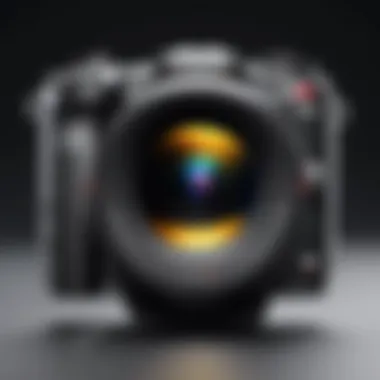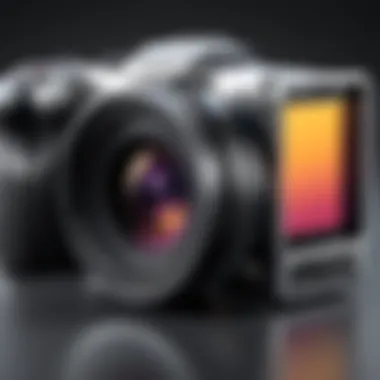Understanding Camera Identifiers in Digital Imaging


Intro
The realm of digital photography is not just about capturing images; it encompasses the technology and tools that enhance our ability to do so. One foundational aspect of this technology is camera identifiers. These identifiers serve as means of categorizing and recognizing various cameras used in photography. An extensive understanding of camera identifiers is crucial for comprehending how images are produced, stored, and utilized across different platforms.
In the following sections, we will examine the intricacies of camera identifiers and their implications on privacy, metadata, and industry standards. This exploration will illuminate how these identifiers operate within the larger framework of imaging technology and how they affect both users and industry stakeholders alike. By delving into these topics, we aim to provide clarity on the significance of camera identifiers in contemporary technology.
Foreword to Camera Identifiers
Camera identifiers are an essential element in understanding the modern digital photography landscape. These identifiers offer unique insights into the devices used, the type of data captured, and how images are processed. As photography has shifted into the digital age, the use of camera identifiers has grown in complexity and importance.
They provide not just technical specifications but also contextual information that plays a role in various aspects of photography, from metadata to privacy concerns. Understanding camera identifiers helps users appreciate how their devices operate and the broader implications these identifiers have in our interconnected world.
Additionaly, discussing camera identifiers can illuminate their significance in fields such as forensic investigations and image authenticity. By exploring their definitions and historical contexts, we can contextualize our current understanding and usage of these vital tools in the photography realm.
Definition of Camera Identifiers
Camera identifiers refer to various unique codes or tags that are attributed to cameras, smartphones, and imaging devices. These identifiers can serve multiple functions, ranging from distinguishing between different models to cataloging data associated with captured images. The most commonly known identifier in the digital photography domain is the EXIF (Exchangeable Image File Format) data. This data is embedded within image files and includes information such as the camera model, exposure settings, shutter speed, and even the GPS location where the photo was taken.
In essence, camera identifiers are integral to how we define and analyze photographs, providing a structured way to categorize and retrieve images based on device specifications and metadata properties.
Historical Context
The evolution of camera identifiers traces back to the beginnings of photography. Early cameras had no formal identifiers, but as technology advanced, camera manufacturers recognized the need for organization and standardization. As film photography transitioned to digital, the necessity for identifiable markers became more pronounced.
In the mid-1990s, Adobe and other entities standardized the EXIF format, enabling cameras to store necessary information about image capture in a consistent manner. This development marked a turning point, as photographers could now not only take pictures but also obtain vital data about those images. As digital cameras became pervasive, the significance of these identifiers increased, leading to their current roles in various applications from casual photography to serious forensic analysis.
Understanding this history not only provides clarity on how identifiers function today but also highlights the ongoing innovations in imaging technology and their broader implications.
Types of Camera Identifiers
Understanding the types of camera identifiers is essential in recognizing their functionality and importance in digital photography. Camera identifiers serve as unique markers that help differentiate various devices and the context in which images are captured. They offer significant insights regarding authenticity, origin, and technical aspects of a photograph. With the increasing prevalence of photography in daily life, knowledge of these identifiers enables informed choices regarding data privacy and content sharing.
Device-Specific Identifiers
Device-specific identifiers refer to the unique codes assigned to each camera or device. These identifiers are crucial because they allow for the tracking of images back to their respective devices. In practical terms, this means that if an image is taken with a Canon EOS 5D, the device identifier reflects its unique specifications. Therefore, when you look at the image metadata, you can confirm the specific model that captured the image. This is vital for photographers and businesses alike.
- These identifiers enhance accountability. In a professional setting, knowing which device captured an image can validate a photographer's work and claims.
- Additionally, they also assist in troubleshooting technical issues. If a certain model is known to have a defect, identifying images taken with that specific device helps isolate the problem.
Geolocation Identifiers
Geolocation identifiers hold particular relevance in a world that places a premium on location-based services. These identifiers augment images with geographical data, allowing one to know the exact location where an image was captured. Many modern cameras and smartphones embed GPS coordinates into the EXIF data of a photograph.
"Knowing the location of the photo adds layers of context and significance, especially in journalism and documentary photography."
The benefits of geolocation identifiers are manifold:
- Enhanced Storytelling: Photographs become more than mere visuals; they tell a story by revealing where they were taken.
- Searchability: Geolocation data can improve the searchability of images in databases, making it easier to locate specific scenes or events.
- Legal and Ethical Considerations: In instances of forensic investigations, location data can provide vital context regarding the occurrence of events.
Model Information


Model information complements device-specific identifiers by providing additional context on the camera being used. This includes the type of lens, settings employed, and sometimes even the firmware version. When one views an image's metadata, the model information often features prominently, allowing comprehensive analysis.
- Understanding model information assists photographers in choosing the right equipment for specific scenarios. For example, a landscape photographer might prefer a camera known for high dynamic range.
- This information can also play a role in marketing. Brands can analyze which models are preferred by certain demographics, guiding future product designs.
In summary, the types of camera identifiers provide a multifaceted insight into photographic data. Device-specific identifiers ensure accountability, geolocation identifiers supply context, and model information aids in informed decision-making. Each plays a vital role in elevating the overall understanding of images in both personal and professional realms.
Role of Camera Identifiers in Digital Photography
Camera identifiers have a significant role in the realm of digital photography. They function as the backbone, providing essential information that enhances the way images are created, stored, and shared. Understanding these identifiers helps in grasping how modern photography operates, especially in an age where digital media is ubiquitous.
One might consider the relationship between camera identifiers and the image creation process. These identifiers allow for the capture of detailed metadata alongside the images, which can include camera settings, geolocation, and the model of the device used for the capture. This metadata is crucial for photographers who wish to analyze their work or replicate certain settings in future shots. Additionally, the identifiers aid in establishing protocols in both professional and amateur photography, ensuring that the images maintain certain standards in quality and representation.
The significance extends beyond the technical aspects. With the rise of social media platforms, the way images are shared and perceived has evolved. Camera identifiers allow for the verification of authenticity in digital content. This verification is more important than ever as misinformation and manipulated images can easily spread through various online channels.
Image Metadata and EXIF Data
Image metadata, particularly EXIF (Exchangeable Image File Format) data, is packed with information collected at the point of image capture. This includes details like date and time, camera settings (such as exposure, aperture), and sometimes even GPS coordinates. Such metadata plays a pivotal role for numerous applications.
For instance, when organizing photographs, metadata allows photographers to sort and categorize their work efficiently. They can filter images based on date, location, or the equipment used. Furthermore, for professionals, this data can assist in providing insights into which settings yield the best results in varying conditions. It can enhance their skills over time by allowing them to reflect on past decisions based on accessible data.
In forensic contexts, EXIF data can provide a clear timeline of when an image was taken. Such information is vital in legal scenarios, where image credibility might be called into question. This capability emphasizes the importance of maintaining accurate metadata during the capture process.
Authenticity and Verification
In an era where digital images can be easily manipulated, the authenticity afforded by camera identifiers becomes indispensable. They help in establishing provenance, allowing viewers to assess whether an image is genuine or altered. Camera identifiers make it possible to trace back to the original device that captured the image, offering a layer of trust for both consumers and creators.
Verification mechanisms built into various platforms often utilize this data to combat misinformation. For example, when images are shared widely, platforms might analyze the metadata to determine the original source and time of capture. This process can help in filtering out deceptive content and upholding the integrity of digital media.
In summary, the role of camera identifiers in digital photography is multifaceted. They enrich metadata, enhance the reliability of images, and establish frameworks for both personal and collective accountability in photography. This underscores the need for keen awareness among photographers and users alike regarding how these identifiers impact their digital experiences.
Impact on Mobile Photography
Camera identifiers significantly shape the landscape of mobile photography. The rise of smartphones as primary photography tools has led to a demand for effective management and utilization of data. With each image captured, camera identifiers serve as crucial links between the device and the image, influencing not only personal use but also social sharing and professional applications.
Integration with Smartphone Cameras
Smartphone cameras often integrate complex systems of identifiers that enhance the user experience. Each photo an individual takes typically contains metadata embedded in the image file. This metadata includes information like camera model, settings, and even location data derived from GPS.
The presence of these identifiers allows for better organization and retrieval of images. A photographer can sort and filter their files based on different criteria, such as camera model or shooting conditions. This functionality is especially important for professionals who manage large portfolios of work.
For example, Apple devices use proprietary identifiers that work seamlessly with their Photos app, enabling users to quickly locate images based on date or location. Similarly, Android devices often utilize features that make the management of these identifiers straightforward, promoting ease of access.
Social Media and Sharing
Social media platforms have transformed how images are shared. Camera identifiers play a pivotal role in this context. Platforms such as Facebook and Instagram often display related metadata, which can enhance user engagement. When a user uploads a photo, the platform can extract identifiers to create a richer experience, providing details such as location tagging and camera settings alongside the photo itself.
Moreover, while sharing images, metadata can aid in authenticity verification. This helps combat misinformation and ensures that users can trace the source of visual content. Such functionalities not only benefit casual users but also serve professional photographers who wish to maintain credibility.
However, the ease of sharing comes with considerations. Users must be aware that by sharing images with embedded camera identifiers, they may unintentionally share personal data. As a result, many users choose to strip metadata before sharing on public platforms. This fact highlights the increasing need for awareness regarding privacy concerns surrounding photography in the digital age.
"Understanding how camera identifiers function can provide users with better control over their digital footprint while still enjoying the benefits of mobile photography."


In summary, camera identifiers are essential for enhancing mobile photography experiences. They facilitate better integration within smartphone systems, promote efficient photo management, and enable a more connected social sharing environment. However, users must navigate the associated privacy implications carefully.
Camera Identifiers in Forensic Investigations
Camera identifiers serve a vital role in forensic investigations. Their ability to link an image to a specific device provides clear evidence that can be indispensable in legal proceedings. By utilizing the unique identifiers associated with cameras, investigators can establish timelines, identify locations, and validate the authenticity of visual evidence.
This section will examine the two critical areas of camera identifiers in forensics: their role in evidence collection and the challenges that come with their use.
Role in Evidence Collection
In forensic settings, camera identifiers can significantly enhance the quality of evidence collection. Images from crime scenes can include essential data like time stamps, geolocation coordinates, and the device used to capture them. These details make it easier for law enforcement to track investigations and build cases.
- Time Stamps: Many cameras embed timestamps in the metadata of photographs. This feature helps investigators construct a sequence of events leading up to and following an incident.
- Geolocation Data: Some camera identifiers include GPS information, pinpointing the exact location where a photo was taken. This is crucial for establishing a crime scene.
- Device Identification: Knowing the specific make and model of a camera can help forensic experts validate the source of the images and confirm their relevance to a case.
"Incorporating camera identifiers into investigations not only strengthens the case but also helps verify the legitimacy of the evidence presented in court."
Challenges and Limitations
Despite the advantages, there are challenges and limitations regarding camera identifiers in forensic investigations. Some of these can hinder their effectiveness:
- Data Tampering: Digital images can be manipulated. An individual might modify metadata to hide or alter crucial information. This makes it difficult to ascertain the authenticity of the results.
- Privacy Issues: The use of camera identifiers raises ethical concerns. Investigators must balance evidence collection with the right to privacy of individuals captured in the images.
- Incompatibility: Different devices may use varying formats for metadata. This inconsistency can create hurdles when aggregating information from diverse sources.
Privacy Concerns Associated with Camera Identifiers
In today’s digital age, the use of camera identifiers has become increasingly prevalent. However, with this rise comes significant privacy concerns. Camera identifiers can reveal sensitive information about users, their locations, and even personal behaviors. Therefore, understanding these privacy implications is crucial for tech-savvy individuals who navigate the complex landscape of digital photography and imaging.
Data Collection Practices
Data collection practices associated with camera identifiers warrant careful scrutiny. Various devices, especially smartphones and digital cameras, embed unique identifiers into the metadata of images. This practice is often unnoticed by users. Nonetheless, it creates a detailed portrait of the user's habits and environments. For instance, when an image is taken, the camera captures not just the visual content but also tags that may disclose the user’s exact GPS location and device type.
This metadata can be collected by service providers or third parties, raising concerns about who has access to this information. Some social media platforms, like Facebook, utilize camera identifiers for functionalities like photo tagging and location sharing. Users often overlook that such settings can expose their personal lives to a wider audience, increasing potential risks.
"Understanding the implications of data collection is essential for maintaining privacy in a digitally connected world."
User Control and Transparency
Another critical element revolves around user control and transparency regarding camera identifiers. Users generally desire more awareness and control over how their data is handled. Many photography apps or devices do not clearly communicate how identifiers are utilized. This lack of transparency can lead to distrust.
As an example, some applications offer features that require camera access, often without detailed explanations on how the data will be used. Users may unknowingly permit excessive data sharing, thinking they are simply using a camera app.
To counteract these privacy issues, developers should implement clearer privacy policies that articulate how data, including camera identifiers, is collected and shared. Enabling users to adjust their privacy settings can significantly enhance their sense of control. Often, allowing toggling of settings related to data collection can empower users to make informed decisions about their privacy.
Standardization and Regulations
Standardization and regulations are critical components of the camera identifier landscape. As technology advances and digital photography becomes more prevalent, the need for a cohesive framework to manage and streamline camera identifiers has never been more imperative. A clear understanding of this topic is essential in various contexts, including image metadata, privacy implications, and industry practices. Without standardization, the myriad of devices and software that utilize these identifiers could lead to disarray, inconsistencies, and potential misuse of information.
Industry Standards for Camera Identifiers
Industry standards establish uniformity in how camera identifiers are generated, formatted, and utilized across different platforms. The most widely recognized standards are governed by international organizations such as the International Organization for Standardization (ISO) and the International Telecommunication Union (ITU). These standards help ensure that identifiers maintain compatibility between devices, software applications, and systems.


Specific elements covered under industry standards include:
- Format Specifications: Defining how identifiers should be structured. This might include ensuring certain characters or formats are used consistently.
- Data Integrity: Establishing protocols for how identifiers are created and maintained to prevent tampering or loss of information.
- Accessibility: Ensuring that all stakeholders, from manufacturers to end-users, can access and utilize these identifiers without excessive barriers.
By adhering to these standards, manufacturers can enhance the user experience, improve interoperability, and bolster confidence in the authenticity of photographic content.
Regulatory Framework
The regulatory framework surrounding camera identifiers includes legal considerations that govern the collection, storage, and sharing of data associated with these identifiers. Nations and regions have developed specific regulations to protect user privacy and intellectual property. For example, the General Data Protection Regulation (GDPR) in the European Union sets stringent rules regarding how personal data can be processed and requires transparency in data handling practices.
Key considerations in the regulatory framework include:
- User Consent: Ensuring that users give explicit permission for their data to be used, particularly when it involves identifiers linked to personal information.
- Data Retention Policies: Regulations dictate how long data associated with camera identifiers can be stored. Companies must comply to avoid penalties.
- Breach Notification: In the event of a data breach, laws require rapid notification to affected individuals, promoting accountability and transparency.
The regulatory framework serves as a balance between the advancement of technology and the protection of individual rights, reinforcing the obligation of companies to act responsibly with user data.
"Without proper regulations, the potential for misuse becomes alarming in a world increasingly reliant on digital photography and its associated identifiers."
The integration of standardization and regulations forms a strong foundation for the ethical and responsible use of camera identifiers in the evolving landscape of digital photography. As technology progresses, ongoing dialogue between industry experts, regulators, and users will be vital in shaping future practices.
The Future of Camera Identifiers
As we approach an era of rapid technological evolution, understanding the future of camera identifiers becomes essential. These identifiers are more than just alphanumeric strings assigned to devices; they reflect advancements in imaging technologies and address emerging concerns regarding privacy and data security. The evolution of camera identifiers will shape how we interact with images and the overarching framework of digital photography.
Technological Advancements
The landscape of camera technology is constantly changing, driven by innovations in hardware and software. Manufacturers are investing heavily in Artificial Intelligence and machine learning, enhancing camera functionality. For instance, modern smartphones leverage AI to improve image processing, resulting in better quality photos. Additionally, advancements in connectivity such as 5G networks facilitate faster data transfer and allow for more efficient integration of camera identifiers with cloud-based services.
With these advancements, camera identifiers are becoming increasingly sophisticated. They may not only tag images but also provide contextual information that can enhance user experience. Such integrations include features like automatic geotagging and device-specific optimizations. This not only enriches the metadata of a photo but also makes camera identifiers more valuable for professional photographers and hobbyists alike.
Emerging Trends in Photography
As consumer preferences shift towards convenience and quality, trends in photography are adapting to these demands. One significant trend is the rise of mobile photography, which now often surpasses traditional cameras in popularity. The ease of sharing images on social media platforms requires robust camera identifiers to manage the increasing volume of images being uploaded.
Moreover, as photography becomes more democratized, there’s a growing focus on user-generated content. The importance of camera identifiers will extend to applications that validate the authenticity of images shared online. Ensuring photo integrity is critical in an era where misinformation can spread rapidly. This trend will likely lead to more stringent standards for camera identifiers, making them pivotal in image verification processes.
As the capabilities of photography evolve, so do the expectations and functions of camera identifiers.
In summary, the future of camera identifiers is intertwined with technological advancements and emerging photography trends. These identifiers not only enhance the quality and usability of images but also play a crucial role in addressing security and authenticity in an increasingly digitized world.
End
The conclusion serves as a vital segment in this exploration of camera identifiers. It encapsulates the essential insights gleaned from the preceding sections, reinforcing the importance of understanding this complex topic in the realm of digital photography.
Summary of Key Findings
Camera identifiers are integral to modern imaging technologies. They provide critical metadata that aids in the classification and tracing of images. Key findings highlight that:
- Types of Identifiers: Various categories exist, such as device-specific identifiers, geolocation identifiers, and model information. Each serves a different purpose in identifying camera origins and characteristics.
- Role in Metadata: Metadata, particularly EXIF data, plays a crucial role in verifying image authenticity and enhancing the searchability of images in databases.
- Forensic Applications: In investigations, the ability to trace back an image to specific camera identifiers can substantiate evidence, though challenges like data integrity and accuracy must be navigated.
- Privacy Concerns: As identifyers are linked to users, there are significant privacy implications. Users often lose control over their data, making awareness critical in today's digital landscape.
- Future Innovations: Advancements in technology persist, shaping how camera identifiers function and interact with emerging trends in photography.
Final Thoughts
Understanding camera identifiers is not merely an academic exercise. It has real-world implications for professionals, enthusiasts, and general users alike. Awareness of the scope and limits of these identifiers can enhance the cautious use of photography in both personal and professional contexts.
The dynamics of digital photography continue to evolve, especially as mobile devices gain prevalence. As technology advances, comprehending these identifiers will be essential for ensuring privacy and understanding metadata's role in our digital lives.
Ultimately, a proactive approach to learning about camera identifiers will empower users to make informed decisions regarding their photography practices, potentially influencing how they share images in an increasingly connected world.







